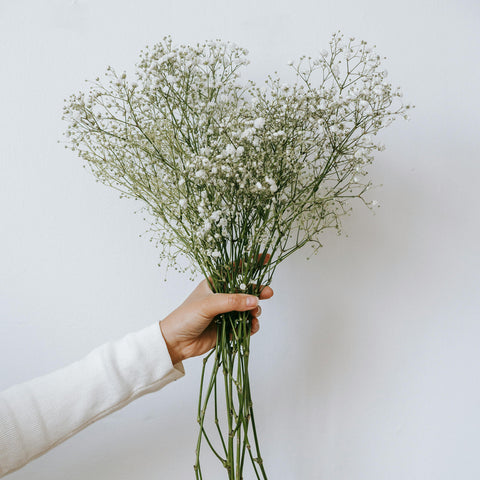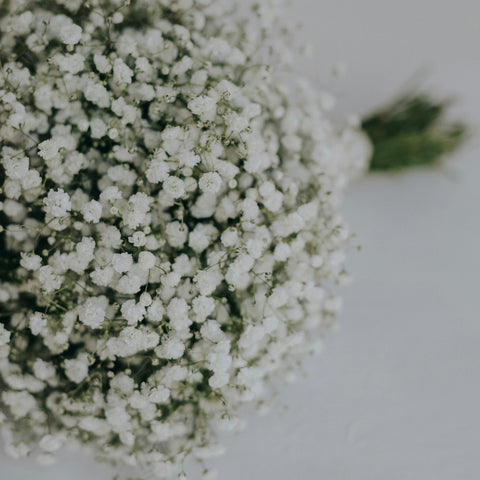Wedding Bouquets With Baby's Breath
With meanings of innocence and everlasting love, there's no surprise that Gypsophila has come to be a popular choice for wedding bouquets. A traditional Gypsophila posy is simple enough to create, whether you are using fresh, dried, or preserved products. We have included a YouTube tutorial that uses fresh flowers, but the other options could be easily exchanged.
Video Guide | How To Make a Gypsophila Bouquet
Watch the video below to see a Gypsophila bouquet made with fresh flowers. The same method can be used with dried or preserved flowers to create the perfect Gypsophila wedding bouquet or Gypsophila bridesmaid bouquet. If you can't see the video below, try using this link.
Start by removing the leaves and side shoots from the base of the Gypsophila stems.This will give you a clean stem to work with and prevent unsightly, wilting foliage from turning your lovely bouquet into a mess. You want the flowers after all!
If you have big bushy stems, cut these into smaller pieces more suitable for your bouquet - they go a long way! Gather your trimmed stems up into a little pile in front of you to make creating the bouquet easier.

Make sure you have some string, ribbon or wire cut and ready for when it's time to tie all the stems together - now you can begin!
To create the bouquet you will need to feed the Gypsophila stems from one hand to the growing bunch in the other. Depending on your dominant hand, hold a couple of stems in the 'bunch' hand and feed the rest of the Gypsophila into it, one by one, in a spiraling technique.
As the bunch grows, the stems will appear to spiral around the centre, keeping the overall bunch tight and tidy, and creating a ball of Gypsophila flowers on top.
When you have all your stems in place, wrap the twine, ribbon or wire around the stems so you have a good solid handle. Depending on what you choose, you may wish to cover it up with a decorative ribbon afterwards. This can be secured into place with a few pins - Et voila!

Alternatives To Fresh Gypsophila Bouquets
Can't find fresh Gypsophila, or need something that's going to last a long while without water? Wedding bouquets have to look good for a long while and depending on weather conditions on a wedding day, dried or preserved flowers may offer a more robust alternative to their fresh counterparts. Why not explore some of the fantastic products available? We offer a range of different options at Atlas Flowers including dried, preserved, and even faux. Let's take a look at each so you can make an informed choice about which is best for you and your client's wedding flowers.
Dried Gypsophila Bouquets
Once harvested, Gypsophila can be dried or preserved, each method leaves the product with a different look and texture. Dried Gypsophila takes on a slightly brittle texture with the flowers shrinking to a tight irregular sphere. It looks lovely in its natural colour, or dyed with bright or pastel hues. Rather than limiting a design to traditional white, these delicate, candy-coloured flowers look great as part of alternative styles of wedding bouquet or posy. Below is a collection of boutonniere-style posies in some amazing colours. We think a dried Gypsophila bouquet would look amazing, and it will last for ages, meaning the items can be kept as souvenirs from the big day.

Preserved Gypsophila Bouquets
Preserved Gypsophila retains a fresh look and feel. As the moisture within the stems is replaced with a glycerine-based solution, either with or without vegetable dye added, so they remain plump stemmed, with larger flowers. If your client is looking for fresh blooms but they aren't available, these may be the perfect compromise. Preserved products can be a florist's best friend, as they are easy to work with, and there is no need to worry about them wilting before the big day.
Bleached, and Bleached and Dyed Gypsophila Bouquets
There's also the option of bleaching, which will render the product creamy to pure white (below left and second left). This allows for colouring the product with pale, pastel dyes that a non-bleached product wouldn't be able to display (below right and second right). These products are not to everyone's taste, as the colour can be flat and uniform, and the flowers are much smaller. Occasionally they retain a slight odour from the bleaching process, which may not be suitable for a wedding bouquet, however with a good airing this will diminish.
Faux Gypsophila Bouquets
Aside from these real flowers, there are also faux products. Artificial Gypsophila comes in different qualities, with some looking more realistic than others. High-quality faux stems are rarely made of silk any longer, but they are designed and manufactured to look and feel as real as possible, indeed the technology behind faux flower production has come a long way over the years, meaning that it's no longer a downgrade to go with faux. The two examples above are from a basic range. We stock premium artificial flowers and foliage from industry leaders, Silk-ka. Silk-ka have perfected their production of ultra-high quality, realistic faux flowers, foliage, and plants. Founded by a Dutch florist, the immense attention to detail sets these products well ahead of most available brands.

Your client may opt for faux for a number of personal and practical reasons, so it is worth knowing that there are a plethora of excellent quality products available. We are always adding to and improving our range of faux, so if you can't see what you're looking for, please get in touch.
Gypsophila Bouquet F.A.Qs
-
How many Gypsophila stems are in a bouquet?
Obviously, that depends on what size you want it, but an average-sized bouquet will only require around 3 - 5 bushy stems, as you will trim these into more pieces as you create the bouquet bunch.
-
Which Gypsophila is best for bouquets?
Again, this is a personal preference, but with regard to fresh Gypsophila, many people prefer Xlence Gypsophila as it has large, bright white flowers. This isn't keen on going long periods without water, however, so we recommend preserved Gypsophila to mimic the look and feel of fresh as best as possible if the bouquet has to be out of water for a long while.
-
How long does dried Gypsophila last?
Dried Gypsophila can last well over a year if great care is taken, and its kept in the right conditions. How long does preserved Gypsophila last? Preserved Gypsophila can last many months, even over a year when looked after correctly and kept in the right environment.
Share Your Makes! Have you created a beautiful Gypsophila bouquet from our dried, faux, or preserved products for a client's wedding? Why not share with us on social media? We love to see happy brides and grooms and are always pleased to share our customer's floral design projects on social media.
